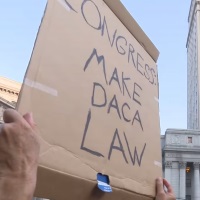
President Donald Trump boasted in his State of the Union address that his legislative proposal to make the DACA program permanent will “generously” cover 1.8 million people — “almost three times more people than the previous administration covered.” That’s a faulty and misleading comparison.
The 1.8 million figure represents the number of people that the White House claims could be eligible for Trump’s proposed program. That’s about the same number as those who are potentially eligible under the current Deferred Action for Childhood Arrivals program, which then-President Barack Obama created by executive action in 2012.
In addition, we cannot verify how many people would actually be eligible under Trump’s plan, because the White House has yet to release any details about the eligibility requirements in the proposal.
Before we lay out what we know about Trump’s proposal and how it compares to Obama’s program, let’s take a step back to explain DACA and why Congress and Trump are now rushing to pass a law to replace it.
Obama created DACA on June 15, 2012, after Congress repeatedly failed to pass the “DREAM Act,” which would have provided a path to citizenship for certain immigrants brought to the country illegally as children. Obama wasn’t able to unilaterally provide these individuals with legal status, but his executive action defers deportation proceedings for two years and provides work authorization in the United States during that time. The program also allows those approved to renew every two years. (See “The Facts on DACA” for more information.)
The Trump administration on Sept. 5, 2017, announced a “wind-down” of the program, which Attorney General Jeff Sessions deemed “an unconstitutional exercise of authority by the Executive Branch.” Trump gave lawmakers until March 5 to come up with a legislative fix.
The Democrats sought to force Republicans to address DACA in a spending bill that Congress had to pass by Jan. 20 to keep the government open. But talks failed to produce a bipartisan agreement on DACA, resulting in a partial government shutdown. The government reopened three days later when the Democrats agreed to fund the federal government until Feb. 8, while Congress seeks to negotiate a DACA deal. Senate Majority Leader Mitch McConnell promised Democrats that the Senate would start debate on a DACA bill before Feb. 8.
As part of the negotiations, the White House offered a one-page “Framework on Immigration Reform & Border Security” that covered four immigration areas, including a permanent DACA program and a $25 billion trust fund for border security, which would partly pay for the president’s proposed wall on the southern border with Mexico.
The president and his press secretary, Sarah Sanders, have both boasted that Trump’s DACA plan would cover three times more people than the one created by executive order in 2012 by President Barack Obama.
Trump made his claim during his State of the Union address.
Trump, Jan. 30: [O]ur framework generously offers a path to citizenship for 1.8 million illegal immigrants who were brought here by their parents at a young age. That covers almost three times more people than the previous administration covered.
A day later on CNN, Sanders said that Trump’s DACA plan “went further than Barack Obama ever did as president. He has tripled the number of people that he has included in this program.” She added, “That is broadening the spectrum and taking it a much step further.”
The White House has released no evidence to show that Trump is “broadening the spectrum,” and if he is, it wouldn’t be by much, judging by the figure he cited.
An estimated 1.3 million people currently meet the eligibility requirements for the existing DACA program, according to the Migration Policy Institute. The institute also estimates that the current program could cover up to 1.9 million people in the next several years — about the same number as the White House claims would be eligible under Trump’s plan. MPI arrives at the 1.9 million figure by including 228,000 people who will meet the age eligibility requirement (at least 15 years old) and 398,000 people who could gain the schooling needed to meet the education requirements.
It’s also worth noting that Obama attempted in 2014 to expand the number of people eligible for DACA and cover their parents by issuing a second order that would have, among other things, eliminated the age cutoff for DACA (under the age of 31 as of June 15, 2012) and changed the residency requirement (to living in the U.S. since June 15, 2010, instead of June 15, 2007). That order, which was blocked from being implemented by the Supreme Court, would have increased the number of potential DACA recipients by 290,000 people, MPI estimates.
So, what is Trump talking about when he says his plan “covers almost three times more people than the previous administration covered”? He is comparing the 1.8 million he says would be eligible for his program to the 689,800 people that the United States Citizenship and Immigration Services says were enrolled in the DACA program as of Sept. 4, 2017.
That’s an apples-to-oranges comparison. A more apt comparison is the number eligible for each program, and that is about the same by the White House’s own estimates.
Asked how the administration arrived at the 1.8 million figure, a senior administration official at a Jan. 24 background briefing told reporters: “It’s a combination of individuals who for all kinds of reasons didn’t apply for DACA and then, as well as, minor adjustments to the time frames and dates of entry issues that would get you to 1.8 million.”
Trump’s boast is also misleading because the total number of people who have ever been approved for DACA is 798,980 since it was launched in 2012, according to USCIS. If measured by that number, which is still an apples-to-oranges comparison, Trump’s plan is closer to covering twice as many people — not three times.
Finally, it is misleading to compare the number of people currently enrolled in DACA with those potentially eligible for Trump’s program, because an executive action is temporary, while a law is a permanent fix. Those eligible for DACA put themselves and family members at risk by signing up for a program that could be rescinded, as Trump has now done.
“Since undocumented youth must reveal their immigration status, names, and addresses to federal agencies, there are likely to be concerns about disclosing personal information,” Tom Wong, a professor of political science at the University of California, San Diego wrote in September 2013. “These concerns are not necessarily confined to the applicant. Children may fear that applying for DACA will somehow lead to negative repercussions for their parents.”
It’s also important to note that we don’t really know how many people will be eligible under Trump’s plan.
We asked the White House to provide the eligibility requirements under the president’s plan and how it differed from the current program. A White House spokesperson declined to provide any details, referring us instead to the vaguely worded one-page “framework.”
The “framework,” for example, calls for “adjusting the time-frame to encompass a total population of approximately 1.8 million individuals” without explaining what adjustments would be made. Michelle Mittelstadt, director of communications and public affairs at the Migration Policy Institute, called that a “wild card,” making it impossible to estimate the reach of Trump’s plan.
“Without more knowledge of what that entails we can’t speak to the implications regarding the estimates of the overall DACA-eligible population,” Mittelstadt told us in an email.
At the Jan. 24 background briefing, the senior administration official said the eligibility requirements would be worked out with Congress. Two leaders in the Senate on this issue are Sens. Dick Durbin, a Democrat, and Lindsey Graham, a Republican. Graham’s office did not get back to us, but Durbin’s office told us that it has yet to see any details of Trump’s plan.
“We have asked the administration the exact same question but they wouldn’t answer,” Durbin spokesman Ben Marter told us. “We have no idea who it will cover because they have released no details.”
Marter noted that the White House “framework” says that applicants need to exhibit “good moral character” in order to be eligible. He said the senator is concerned that the Trump administration would use that requirement to reduce the number of people covered by what law Trump signs.
“This is a technical term in immigration law that gives the Trump Administration vast discretion to deny applications for even non-criminal conduct like extramarital affairs, essentially anything they want,” Marter said in an email.
The deadline for congressional action is fast approaching and, at this point, there has been no progress. Both sides are blaming each other. The outcome is still uncertain, but what we know is that Trump makes a faulty, and misleading, comparison when he says his proposed solution “covers almost three times more people than the previous administration covered.”
The post Trump’s Misleading DACA Boast appeared first on FactCheck.org.


 FactCheck.org Rating:
FactCheck.org Rating: 
